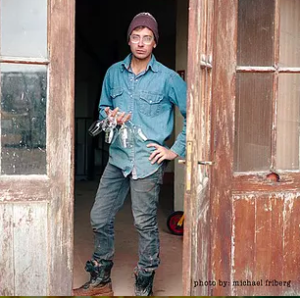
The most interesting natural wines are inextricably intertwined with the personality of the winemakers who make them.
Each bottle an origin story of sorts that fuses the natural forces at work in the vineyard, the characteristics of the grape with the intent and beliefs of the artisan that crafts it all together.
This is singularly true of Evan, founder and winemaker of Ruth Lewandowski Wines in Salt Lake City.
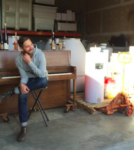 Part Rudolph Steiner romantic, part viticulturist, part dreamer of a wine culture driving sustainable agriculture in the high desert of Utah. And part, mellowed spiritualist stemming from his Catholic and Evangelical upbringing.
Part Rudolph Steiner romantic, part viticulturist, part dreamer of a wine culture driving sustainable agriculture in the high desert of Utah. And part, mellowed spiritualist stemming from his Catholic and Evangelical upbringing.
All parts though, uniquely talented, creative vigneron and artisan of handmade natural wines.
Evan’s backstory starts with working with my friend Zev Rovine, then the owner of The Spotted Frog wine bar in Park City; later the founder of Rovine Selections, one of the earliest and most influential of the boutique natural wine distributors.
That was in 2004 and started Evan, then 21, a graduate of University of Utah, on a journey of wine discovery. It took him to an internship at Ferrari-Carano, a degree in Viticulture from Walla Walla, and travels studying winemaking through Australia, New Zealand, Argentina, Italy, ending with a gig with Christian Binner at Domaine Audrey in the Village of Ammerschwihr, in Alsace, France.
A grand walkabout culminating in the founding of Ruth Lewandowsky Wines in Salt Lake City in 2012.
 My connection to this saga, started with a bottle of Evan’s Chilion that I bumped into at Chambers Street Wines. A long duration, skin-macerated, 100% Cortese grape grown at Fox Hill Vineyard in Mendocino, California and made in Salt Lake.
My connection to this saga, started with a bottle of Evan’s Chilion that I bumped into at Chambers Street Wines. A long duration, skin-macerated, 100% Cortese grape grown at Fox Hill Vineyard in Mendocino, California and made in Salt Lake.
I fell hard for this bottle.
Almost no fruit in the front palate, deeply textured, creamy, vibrant and crazily fresh. I loved it and was curious about the medley of naming and iconographic myths surrounding the bottle and the winemaker.
Here’s the thing about Evan and his wine.
There’s certainly complexity to his personal story riddled with Old Testament references to the Book of Ruth in his wineries name (Ruth Lewndowski is not his mother!), inferences of rebirth and religion, and the nomenclature of biblical characters in each of his wine’s names. Elucidating and layered but I look to the vineyard to really understand his work and intent.
After drinking many bottles of his wine. Lots of back and forths, and a long Skype with him, the guy I got to know is a down-home mythologist, a quite brilliant viticulturist who thinks more like a grower than a winemaker and embraces the patient learnings from the vagaries of the vineyard and the vines themselves as gospel.
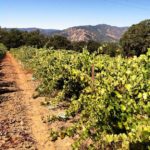 He shared the tale of the Cortese grape, the grape variety in the bottle of Chilion.
He shared the tale of the Cortese grape, the grape variety in the bottle of Chilion.
How this most scraggly of grapes in the vineyard is in a perpetual state of struggle. How the vines canopy cover is never full enough to shade the grape, so there is variable ripeness cross the clusters during harvest. Some are always exposed, some partial, some hardly at all. How Cortese’s core character is its lack of conformity, its lack of innate nutrients and an astounding low nitrogen count at harvest.
And how counter-intuitively, counter to the imagination even, the wine transforms dramatically, even gaining nitrogen during the long fermentation process.
 How loving this variety, taught him that patience is the pulse of nature, that perfection is an abstraction, that while knowledge is key to decision making, we need be open and leave room for the mystery of it all.
How loving this variety, taught him that patience is the pulse of nature, that perfection is an abstraction, that while knowledge is key to decision making, we need be open and leave room for the mystery of it all.
That the best wine is always more than the sum of its parts.
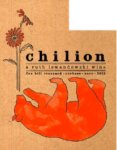 He chose the lounging, inebriated bear on the label of Chilion as an icon with folklorish purpose. How at the Fox Hill Cortese vineyard in Mendocino where the grapes are grown, before they put up deer fences, it was thought time to pick when a bear ambled by, swiped and gorged on the fruit indicating with a natural gesture, that it was time for the harvest
He chose the lounging, inebriated bear on the label of Chilion as an icon with folklorish purpose. How at the Fox Hill Cortese vineyard in Mendocino where the grapes are grown, before they put up deer fences, it was thought time to pick when a bear ambled by, swiped and gorged on the fruit indicating with a natural gesture, that it was time for the harvest
This is the origin story of this bottle of Chilion, my favorite of Evan’s wines. An exceptional bottle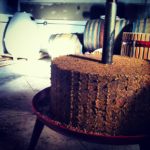 that captures the creaminess of the grape, the grip of the skin. A texture and vibrancy that stay with you long after the glass is empty.
that captures the creaminess of the grape, the grip of the skin. A texture and vibrancy that stay with you long after the glass is empty.
He started making this wine in 2012 during his first harvest with his new winery, with a 7-week skin maceration. The results were not what he dreamed of. In year two, he took a giant leap, gave himself over to the process and with 2 tons of Cortese grapes, moved to a 6-month maceration.
A long hibernation state of sorts where you pick a multi-ripe crop, crush and put in the huge eggs in Mendocino. Seal, strap in the refrigerated truck to his facility in Salt Lake City and simply wait. The results are this great bottle that inspired this post and made me rethink my preconceptions of what Cortese as a grape is all about.
Ruth Lewandowski Wines as a spontaneous happenstance is a truly intriguing mashup.
A grand vision of the power of natural wines as true expression, a reimagined wine culture in the high desert, a personal love of Utah as an outdoorsperson, a location that is alcohol unfriendly at its best, and the dedication to hunker down and work through this most unpragmatic process of wine making, growing in California, trucking to Utah after the crush till his local grapes are someday ready.
The winery opened in 2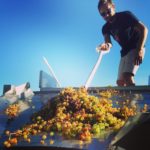 012 and made 300 cases, growing grapes in two vineyards in Mendocino. Partnering with his buddy Sam Bilbro from Idlewild Wines, crushing the grapes to start fermentation and driving the truck himself to his facility in Salt Lake.
012 and made 300 cases, growing grapes in two vineyards in Mendocino. Partnering with his buddy Sam Bilbro from Idlewild Wines, crushing the grapes to start fermentation and driving the truck himself to his facility in Salt Lake.
In 2o18 he will make around 1900 cases, adding three new Mendocino sites and moving to a commercial trucker to move the Flextank 230-gallon, polyethylene eggs to Utah.
Growing grapes in Utah?
They actually do grow some grapes in Boaz, Utah. But it is too hot, the summers to long, and not suitable for Evans dream of creating a sustainable cash crop with grapes to change the agricultural ecosystem in the high desert. And as well, supply grapes for his own wines.
He hunted down the right spot in Boulder Town, Utah, population 20, elevation 6400 feet with 18-21 inches of rain as the place to do it. The place he thinks that just maybe he can incubate a grape growing wine culture as a vigneron.
It will not happen this year, but knowing Evan, it will most certainly be done.
He is a man of profound focus and will.
A big thanks!
 A big thank you to Evan for his patience in chatting with me. To my good friend Ariana Rolich for the intro and the folks at Chambers Street Wines for tolerating my endless questions.
A big thank you to Evan for his patience in chatting with me. To my good friend Ariana Rolich for the intro and the folks at Chambers Street Wines for tolerating my endless questions.
My suggestion is to find this bottle and try it. His other wines as well.
They will certainly not disappoint and may open your eyes to a different approach that uniquely utilizes this variety to create a structured, vibrant altogether new expression of this grape. And one of the best skin-contact white wines coming out of the New World this year.
Retails around $35 generally.
Evan is a highly likable, interesting and authentic individual with not a hint of conceit to him. A talented artisan with a penchant for stories of rebirth and hope, with a generous touch that reflects itself in his opinions, his decisions, his patience and some kick-ass natural juice.
This bottle especially captures it all.
_______________________________
Chilion 2015, Fox Hill Vineyard, Mendocino, California
- 100% Cortese Grape
- 5 hectare vineyard
- Pebbly sandstone
- 17 year old vines avg
- 35 hl/ha yield
- Hand harvest
- Full skin fermentation for 6 month.
- Polyethylene egg aging
- No fining, filtration or sulfur added

